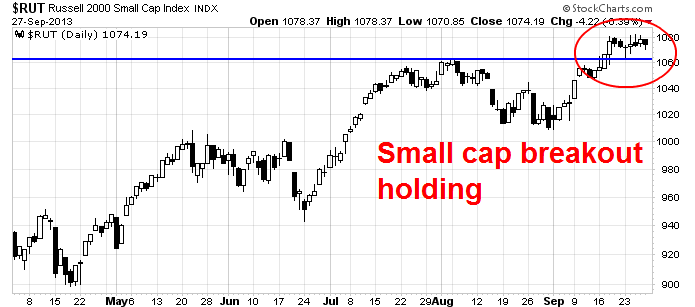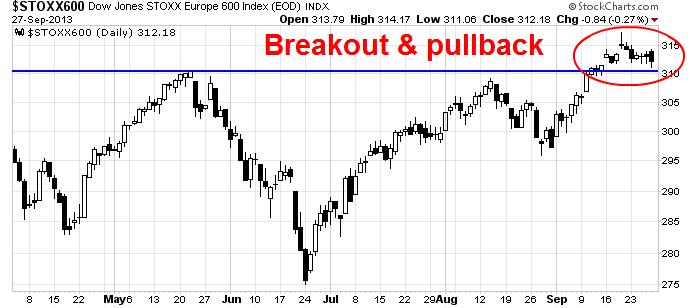As I write these words, ES futures are deeply red and it seems that we are on track for a shutdown of the US government. Is it time to get more cautious? Looking out over the next few weeks, I can't get overly excited about the drama in Washington. Here's why:
The big question for traders is, did the SPX stage a false breakout or is this more of a classic breakout and pullback technical test?
I tend to think that the latter case is the more likely one. Consider the Russell 2000 small caps, whose upside breakout has held above its resistance turned support level:
Cyclical stocks, as measured by the Morgan Stanley Cyclical Index, has staged an upside relative breakout and that breakout has also held up well. This is an indication of an improving global economy.
Across the Atlantic, the STOXX 600 also staged an upside breakout to new recovery highs. While that index has pulled back a bit, the breakout also held above its resistance turned support level after the German election of September 22.
My favorite indicator of Chinese strength is the AUD/CAD currency cross, as both are resource economies but Australia is more sensitive to China while Canada is more sensitive to US growth. The AUD/CAD rate broke out of a downtrend in early August and it remains in a minor uptrend, indicating strength in China's economy.AUD/CAD Daily" title="AUD/CAD Daily" src="https://d1-invdn-com.akamaized.net/content/pic59b4c970c578b71486e5d457b026e1c5.png" height="308" width="694">
Near-term political risks
The fly in the ointment is the impasse in Washington. I don't have a lot to add to the analysis, but I'll quote a couple of people that I have much respect for. Anatole Kaletsky recently wrote (see Why markets don't fear a government shutdown) that a deal will eventually be made despite all the posturing. That's because the political landscape changed in 2012 [emphasis added]:
First and foremost, the 2012 election decisively shifted Washington’s balance of power, not only by providing President Obama with a new democratic mandate, but also by transforming the political incentives for both sides. Until last November, Obama risked losing his bid for re-election if fiscal gridlock damaged the economic recovery. The Republicans, by contrast, could hope to benefit from any setbacks to economic growth. Now, the tables are turned.
Obama will never again face voters and so can afford to risk a budgetary confrontation. Republican congressmen, on the other hand, stand to lose their own seats and their party’s control of Congress by overplaying their hand, especially when opinion polls suggest that Republicans will be blamed if a budget breakdown damages growth or triggers a setback on Wall Street.
Kaletsky believes that the GOP hardliners hold a weak political hand:
[T]he big spending reductions implemented since the 2011 budget crisis have left little scope for further significant reductions in discretionary spending. Fiscal conservatives now recognize that the only programs large enough to transform the budgetary outlook are Social Security, Medicare and Defense — but these programs tend to be strongly supported by elderly and conservative voters.
That, in turn, implies a fourth political transformation. The Republicans are no longer trying to extract major spending reductions in exchange for their budgetary votes. Whereas previously, Republican leadership insisted that any increase in the debt ceiling must be matched dollar for dollar by public spending cuts, this “Boehner Rule” has been quietly dropped. Instead, Republicans are now using budget votes to advance a political cause, the abolition of Obamacare, which is purely symbolic because it offers no scope for compromise with the president and therefore no chance of enactment.
While Kaletsky was wrong in that he did not believe that a government shutdown would occur, his conclusions remain valid:
In sum, the fiscal uncertainty in Washington is almost over — and once the gridlock is broken, the U.S. economy and financial markets could jump back to life like a coiled spring. Remember what happened last January after the fiscal cliff was resolved.
Jeff Miller had a similar take, though it suggests that markets may experience some near-term volatility:
Here is my current working hypothesis:
1.The shutdown will occur, with most scoffing at the effects;
2.Complaints will start to build;
3.Regardless of who wins the blame game, a continuing resolution will be passed;
4.The timing may stretch into the anticipation of a default on debt;
5.Consumers, foreigners, and markets may lose confidence if the debt ceiling deadline is approached; (See the FT's Take)
6.There is little incentive for politicians to resolve this issue early, and some incentive (posturing for constituent groups) to wait until the last minute;
7.The government shutdown may actually encourage an earlier resolution to the debt ceiling issue; (See Ezra Klein's take)
8.Investors have seen the story before, and might not react as violently; and finally 9.The U.S. will not default on its debt. This mainly rests on the understanding of the consequences by business leaders, who will lean on mainstream Republicans if the issue gets close. See this summary.
There are many points in this chain, and each one is open to debate. I emphasize the importance of understanding the limits of forecasts, so we must all realize that this is a fluid situation.
Where are the bearish catalysts?
In the meantime, we have signs of a cyclical upturn globally and an accomodative Fed. These are the signs of a sweet spot for equity returns. Tactically speaking, this study shows that while stocks tend to fall during past government shutdowns, they rallied strongly afterwards.
Longer term, however, I do worry about signs of excessive valuation for the stock market (see A new secular bull? Don't count on it).
In order for stocks to go down, you need a catalyst. For now, fundamental and technical momentum remains positive. Here are the questions that I continually ask myself:
- How are Street earnings behaving? Answer: Brian Gilmartin reports that forward 12 month earnings estimates fell last week. However, they had been steadily advancing for the previous few weeks. We'll have to see if the latest downtick is a blip or the start of a downtrend.
- Are there any signs of an economic downturn? Answer: Not really.
- Is the Fed becoming less accommodative? Answer: No.
Until we see some macro event that derails the market, or the American consumer, who has been an engine of global growth and whose strength continues to surprise me, start to slow, the path of least resistance for stocks is up and I would view shutdown related weakness as an opportunity to add to equity positions.
Disclosure: Cam Hui is a portfolio manager at Qwest Investment Fund Management Ltd. (“Qwest”). The opinions and any recommendations expressed in the blog are those of the author and do not reflect the opinions and recommendations of Qwest. Qwest reviews Mr. Hui’s blog to ensure it is connected with Mr. Hui’s obligation to deal fairly, honestly and in good faith with the blog’s readers.”
None of the information or opinions expressed in this blog constitutes a solicitation for the purchase or sale of any security or other instrument. Nothing in this blog constitutes investment advice and any recommendations that may be contained herein have not been based upon a consideration of the investment objectives, financial situation or particular needs of any specific recipient. Any purchase or sale activity in any securities or other instrument should be based upon your own analysis and conclusions. Past performance is not indicative of future results. Either Qwest or I may hold or control long or short positions in the securities or instruments mentioned.
